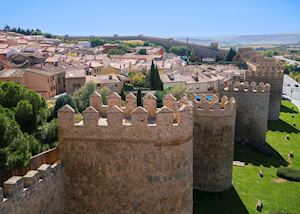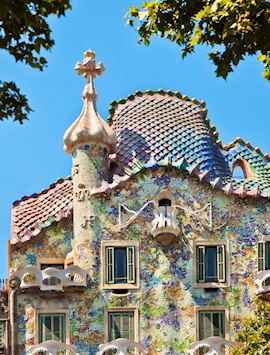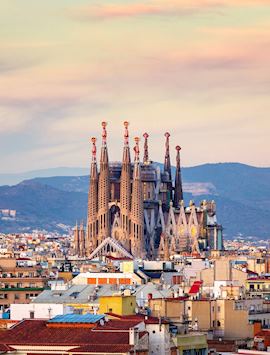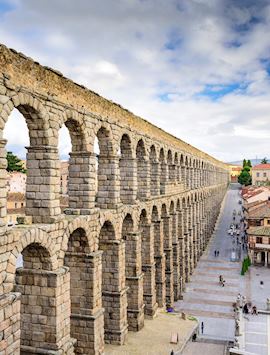Jump to:
Ávila rises up from the boulder-strewn plains like some medieval mirage, its 11th- and 12th-century granite walls glowing golden in the sun. They’re so well preserved that you half expect to see El Cid himself riding out from one of the gates. Inside the walled old town, you pick your way along car-free cobbled streets and past hushed working convents and colonnaded plazas. Stop at a pastelería (cake shop), and you can sample some of the city’s celebrated yemas (egg yolk) pastries.
It’s possible to walk along several sections of the walls, although you can also take in the multitude of towers, merlons, archways, battlements and gates at street level. What’s not always immediately apparent is the walls’ thickness — at 3 m (nearly 9 ft) wide, they were a formidable defensive tool for the Kingdom of Castile against invading Moors. Construction first began under Raymond of Burgundy in 1090.
 Close inspection of the walls’ perimeter reveals why it’s impossible to walk their entire length. At certain points, Romanesque buildings are incorporated into the fortifications, including the apse of Ávila’s cathedral. It’s half house-of-God, half-fortress, with merloned towers and sentry walks an integral part of the cathedral’s structure.
Close inspection of the walls’ perimeter reveals why it’s impossible to walk their entire length. At certain points, Romanesque buildings are incorporated into the fortifications, including the apse of Ávila’s cathedral. It’s half house-of-God, half-fortress, with merloned towers and sentry walks an integral part of the cathedral’s structure.
Step inside, and you’ll see how the ochre-red and white stone of the Romanesque portion of the cathedral gives way to the airier Gothic section built in pearly white stone. In reality, their proportions are similar. Ávila’s cathedral was, in fact, Spain’s first Gothic edifice, seen in its flying buttresses, ribbed vaults and cloisters.
Near the cathedral, you come to the 17th-century Convento de Santa Teresa de Jesús (Convent of Saint Teresa), which was built on the spot where the beatified Teresa, an Ávila noblewoman, was born.
As a functioning Carmelite convent, certain areas are closed off to visitors. But you can tour the small museum containing Saint Teresa’s relics (including her rosary and the remains of her ring finger) and a peaceful garden where she’s said to have played during her childhood. The museum also contains several paintings depicting Teresa in the various states of mystical ecstasy for which she became famous, and a chapel whose frescoes show the saint levitating.
You’ll also find Saint Teresa’s face on the boxes of ubiquitous yemas, sold in all the Ávila’s pastry shops. Rich yellow pastry balls sprinkled with icing sugar, they fit snugly into the palm of your hand and dissolve in your mouth with a burst of lemon-scented sweetness.
Best time to visit Ávila
Ávila is at its best in the spring (March to May) — it can be chilly, but it means you avoid the heat of the summer (June to August), which can make exploring the unshaded city walls and narrow streets more uncomfortable.
who's been there
-
01993 838 92501993 838 081
- Make an enquiry
Suggested itineraries featuring ├ü▒╣Š▒▒¶▓╣
Our itineraries will give you suggestions for what is possible when you travel in ├ü▒╣Š▒▒¶▓╣, and they showcase routes we know work particularly well. Treat them as inspiration, because your trip will be created uniquely by one of our specialists.
Places near ├ü▒╣Š▒▒¶▓╣
- El Escorial & Valle de los Ca├Łdos 32 miles away
- Segovia 37 miles away
- Salamanca 55 miles away
- Madrid 55 miles away
- Toledo 66 miles away
- La Rioja 170 miles away
- ░õ├│░∙╗Õ┤Ū▓·▓╣ 192 miles away
- Asturias 194 miles away
- Oviedo 197 miles away
- Bilbao 202 miles away
- The Basque Country and La Rioja 205 miles away
- Galicia 221 miles away
- San Sebasti├Īn 232 miles away
- Andalusia 237 miles away
- Seville 237 miles away
- Pontevedra 239 miles away
- Granada 248 miles away
- Santiago de Compostela 251 miles away
- A Coru├▒a 268 miles away
- Ronda 272 miles away
- Costa del Sol 273 miles away




